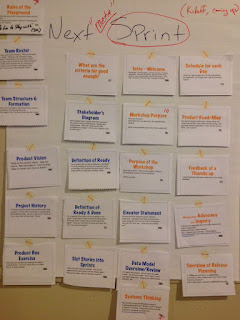Here's a overview of a Scrum Immersion workshop done at GameStop this month. A case study example.
Normally these workshops start with the leadership (the stakeholders or shareholders) which have a vision for a product (or project). This time we skipped this activity.
Once we have alignment on the Product Owner role and the Project Vision we typically do a second workshop for the PO to elaborate the Product Vision into a Backlog. This time we skipped this activity.
Once we have a PO engaged and we have a Product Backlog it is time to launch the team with a workshop - this activity typically requires from 2 to 5 days. This is the activity we did at GameStop this week.
Images from the workshop
The team brainstormed and the prioritized the objectives and activities of the workshop.
The team then prioritized the Meta backlog (a list of both work items and learning items and activities) for the workshop.
A few examples of work products (outcomes) from the workshop.
Release Planning: Using the concept of deriving duration based upon the estimated effort. We made some assumptions of the business desired outcome; that was to finish the complete product backlog by a fixed date.
That didn't feel good to the team, so we tried a different approach. To fix the scope and cost, but to have a variable timeframe.
That didn't feel good to the PO, so we tried again. This time we fixed the cost and time, but varied the features, and broke the product backlog into milestones of releasable, valuable software.
This initial release plan feels better to both the team and the PO, so we start here. Ready for sprint planning tomorrow.
Normally these workshops start with the leadership (the stakeholders or shareholders) which have a vision for a product (or project). This time we skipped this activity.
The purpose of the Workshop is to ensure alignment between the leadership team and the Agile Coaches with regards to the upcoming scrum workshop for the team(s). Set expectations for a transition from current (ad-hoc) practices to Scrum. Explain and educate on the role of the Product Owner.
Expected Outcomes:
- Create a transition plan/schedule
- Set realistic expectations for transition and next release
- Overview of Scrum & leadership in an Agile environment
- Identify a Scrum Product Owner – review role expectations
- Alignment on Project/Program purpose or vision
- Release goal (within context of Project/Program & Scrum transition)
Once we have alignment on the Product Owner role and the Project Vision we typically do a second workshop for the PO to elaborate the Product Vision into a Backlog. This time we skipped this activity.
The purpose of the Workshop is to educate the Product Owner (one person) and prepare a product backlog for the scrum immersion workshop. Also include the various consultants, SME, BA, developers, etc. in the backlog grooming process.
Expected Outcomes:
- Set realistic expectations for transition and next release
- Overview of Scrum & Product Owner role (and how the team supports this role)
- Set PO role responsibilities and expectations
- Alignment of Release goal (within context of Project/Program & Scrum transition)
- Product Backlog ordered (prioritized) for the first 2 sprints
- Agreement to Scrum cadence for planning meetings and grooming backlog and sprint review meetings
Once we have a PO engaged and we have a Product Backlog it is time to launch the team with a workshop - this activity typically requires from 2 to 5 days. This is the activity we did at GameStop this week.
The primary purpose of the workshop is to teach just enough of the Scrum process framework and the Agile mindset to get the team functioning as a Scrum team and working on the product backlog immediately after the workshop ends (begin Sprint One).
Expected Outcomes:
- Set realistic expectations for transition and next release
- Basic mechanics of Scrum process framework
- Understanding of additional engineering practices required to be an effective Scrum team A groomed / refined product backlog for 1- 3 iterations
- A backlog that is estimated for 1 – 3 iterations
- A Release plan, and expectations of its fidelity – plans to re-plan
- Ability to start the very next day with Sprint Planning
Images from the workshop
The team brainstormed and the prioritized the objectives and activities of the workshop.
 |
| Purpose and Objectives of the Workshop |
 |
| Meta Backlog of workshop teams - ordered by participants |
 |
| Possible PBI for Next Meta Sprint |
 |
| Possible PBI for Later Sprints |
 |
| Possible PBI for Some Day |
 |
| Possible PBI for Another Month or Never |
A few examples of work products (outcomes) from the workshop.
 |
| Affinity grouping of Persona for the user role in stories |
 |
| Project Success Sliders activity |
 |
| Team Roster (# of teams person is on) |
 |
| A few team members working hard |
 |
| Three stories written during elaboration activity |
 |
| A few stories after Affinity Estimation |
Release Planning: Using the concept of deriving duration based upon the estimated effort. We made some assumptions of the business desired outcome; that was to finish the complete product backlog by a fixed date.
 |
| The 1st iteration of a Release Plan |
 |
| The 2nd iteration of a Release Plan |
 |
| The 3rd iteration of a Release Plan |

Comments